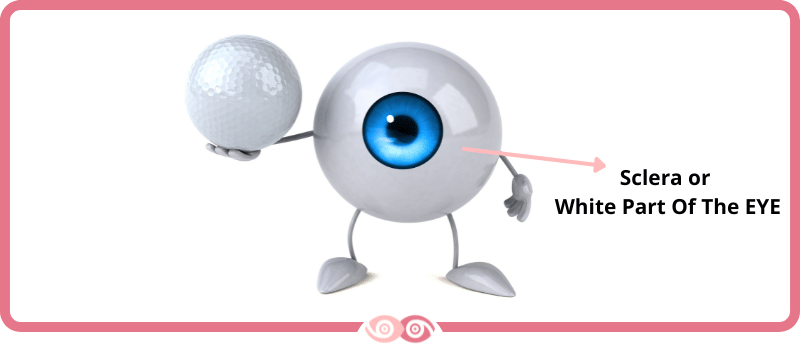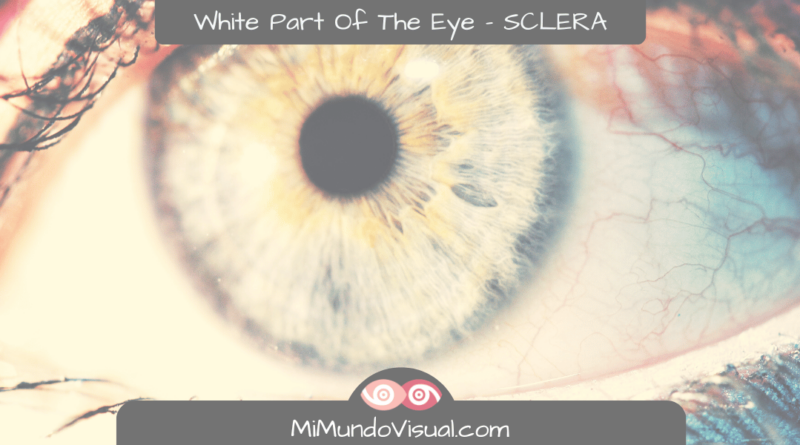What Is The White Part Of Our Eyes Called?
Table Of Contents
The whites of our eyes are called the sclera. It comes from Greek and means ‘membrane covering the eye’ from ‘sklerotes’ (hardness)
But if you want to know more, apart from knowing what the white part of the eyes is called, read on to learn more about the sclera below.
Today we are going to learn:
- What is the sclera of our eyes?
- What is the sclera made of?
- What function does the white part of your eye have?
- What are the different layers of the sclera?
What Is The Sclera Of The Eye?
The sclera or sclera is a membrane that belongs to the outer layer of the eye and is characterized by giving the eye its white color.
As mentioned, this white part of the eye is called the sclera. It is opaque and fibrous, elastic, and resistant.
The sclera is located from the cornea to the optic nerve, is covered by the conjunctiva, and covers the choroid.
The sclera is the outer part of the eye with the largest surface area. Its shape is spherical and has a diameter of 22 mm. In contrast, its thickness is no more than one millimeter.
Embryologically, the sclera comes from the neural crest and mesoderm cells.
If you want to know more about the formation of the eye, you should read: How is the eye formed?
Esta parte blanca del ojo, llamada esclera (o esclerótica) como ya hemos comentado, es opaca y fibrosa, elástica y resistente.
La esclerótica la situamos desde la córnea hasta el nervio óptico, está cubierta por la conjuntiva y cubre la coroides.
Además, la esclera es la parte exterior del ojo con la superficie más grande, su forma es esférica y tiene un diámetro de 22 mm. Por el contrario, su espesor no tiene más de un milímetro.
Embriológicamente, la esclera proviene de las células de la cresta neural y el mesodermo.
Si quieres conocer más sobre la formación del ojo, no puedes dejar de leer: ¿Cómo Se Forma El Ojo?


What is the sclera composed of?
The sclera comprises collagen, elastic fibers, proteoglycans, melanocytes, and fibroblasts.
Sixty-eight percent of the sclera is composed of water, and fibers constitute 75% of its dry weight.
The collagen fibers, which form the sclera, are tough and crisscross in different random directions, which gives the eye its white color and strength.
The outer surface of the sclera is white. It connects with the inner surface of the aponeurotic sheath of the eyeball.
It is covered by conjunctival epithelium from the inner surface of the eyelids to the anterior corneal epithelium.
On the inner surface of the sclera, some indentations branch the ciliary nerves and vessels.
The sclera is separated from the choroid by a peri choroidal space. Posteriorly, it is perforated by fascicles of the optic nerve.
These fascicles pass through the ‘lamina cribrosa sclerae’ of the sclera, through which also pass the central retinal vessels, nerves, and short ciliary arteries.
Towards the back, the sclera continues with the dura mater surrounding the optic nerve. Towards the front, it continues with the cornea. The line of junction between the two is known as the limbus or sclerocorneal junction.
Near the limbus or sclerocorneal junction is the venous sinus of the sclera or Schlemm’s canal.
What is the function of the whites of the eyes?
The sclera supports the eye, helping to maintain its shape and protecting it from injury.
The conjunctiva, a transparent membrane that lubricates the eye, covers the sclera.
In turn, the muscles attached to the sclera provide movement of the eyeball upward, downward, and sideways.
What Is The Function Of The White Part Of The Eye?
The function of the sclera, or ‘white part of the eye,’ is to maintain the eyeball’s shape, contain the eye’s pressure, and protect its internal elements.
What Exactly Does The Sclera Protect?
The sclera is made up of 3 layers. The layers of the sclera are lamina fusca, scleral stroma, and episcleral layer.
What Are The 3 Layers Of The Sclera?
La esclerótica está formada por 3 capas. Las capas de la esclera son: lámina fusca, estroma escleral y lámina epiesclera.
#1 Lamina Fusca
Lamina Fusca is the innermost layer and is located next to the choroid. This layer is composed of collagen fibers and pigmented cells. Its name derives from its coloration, which is dark due to melanocytes (fuscus from Latin, dark).
#2 Estroma escleral
Esta capa fibrosa contiene abundantes fibras de colágeno que favorecen la resistencia de la esclera.
#3 Episcleral Layer
The episclera is the outermost layer, and its function is to facilitate the sliding of the eyeball with other structures.

Conclusions & Summary about the Sclera
To conclude, we have learned the white part of the eye is called:
- The white part of the eye is called the sclera or sclera, which means ‘membrane that covers the eye.’
- The sclera or sclera is an opaque, fibrous, elastic, tough layer that covers most of the eye (from the cornea to the optic nerve).
- It comprises collagen, elastic fibers, proteoglycans, melanocytes, and fibroblasts.
- Its primary function is to support the eye, maintain its shape and protect it from external and internal injuries.
- The conjunctiva, a transparent membrane that lubricates the eye, covers the sclera. And the muscles that are attached to the sclera make the movements of the eyeball possible.
- The eye’s white part comprises 3 layers: lamina fusca, scleral stroma, and episcleral lamina.
We hope this article has helped expand your knowledge of the sclera, its structure, and its function. It should help us on our path to understanding the anatomy and functioning of our eyes.
And finally, a curious fact:
Did you know that humans are the only primates that have white sclera?

